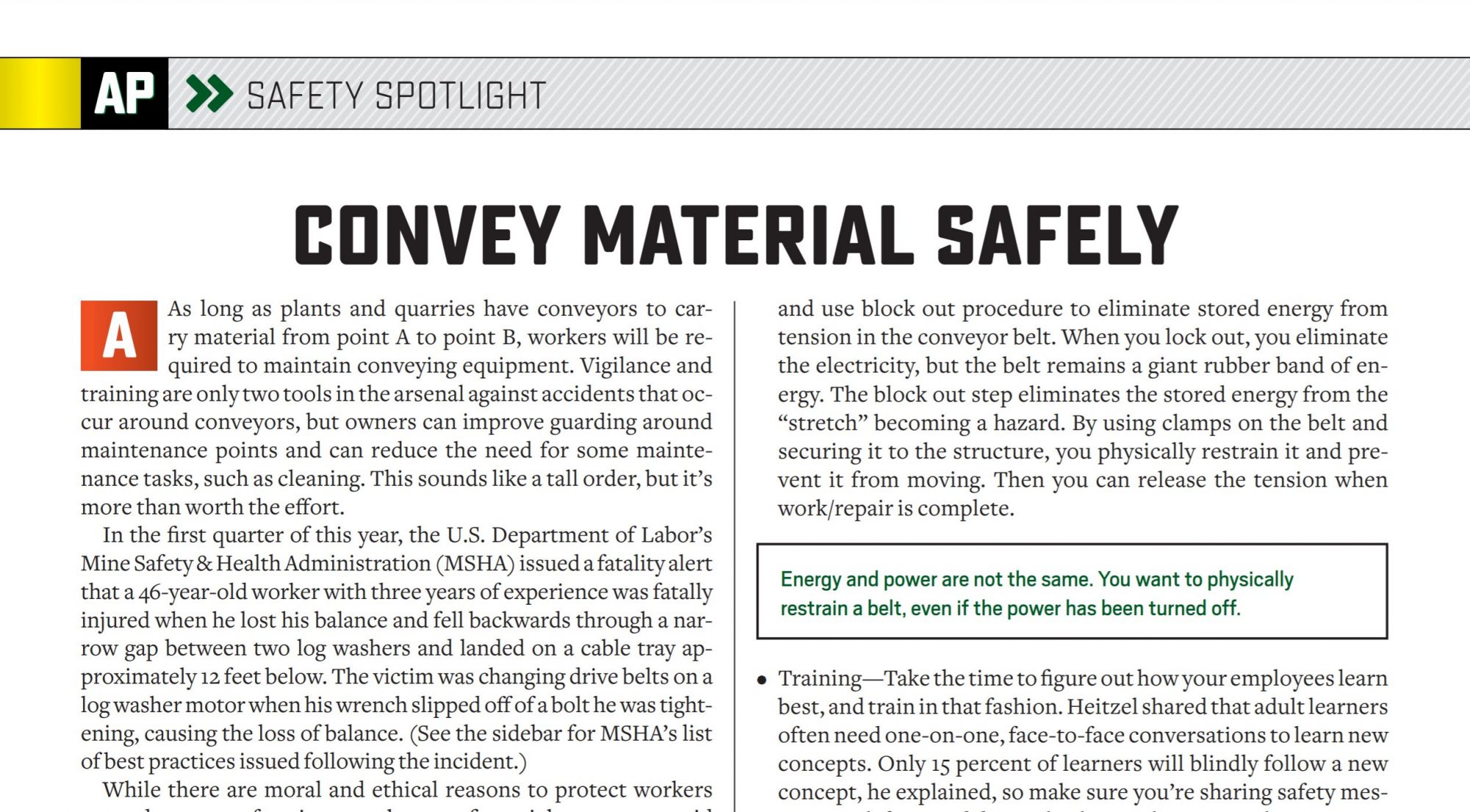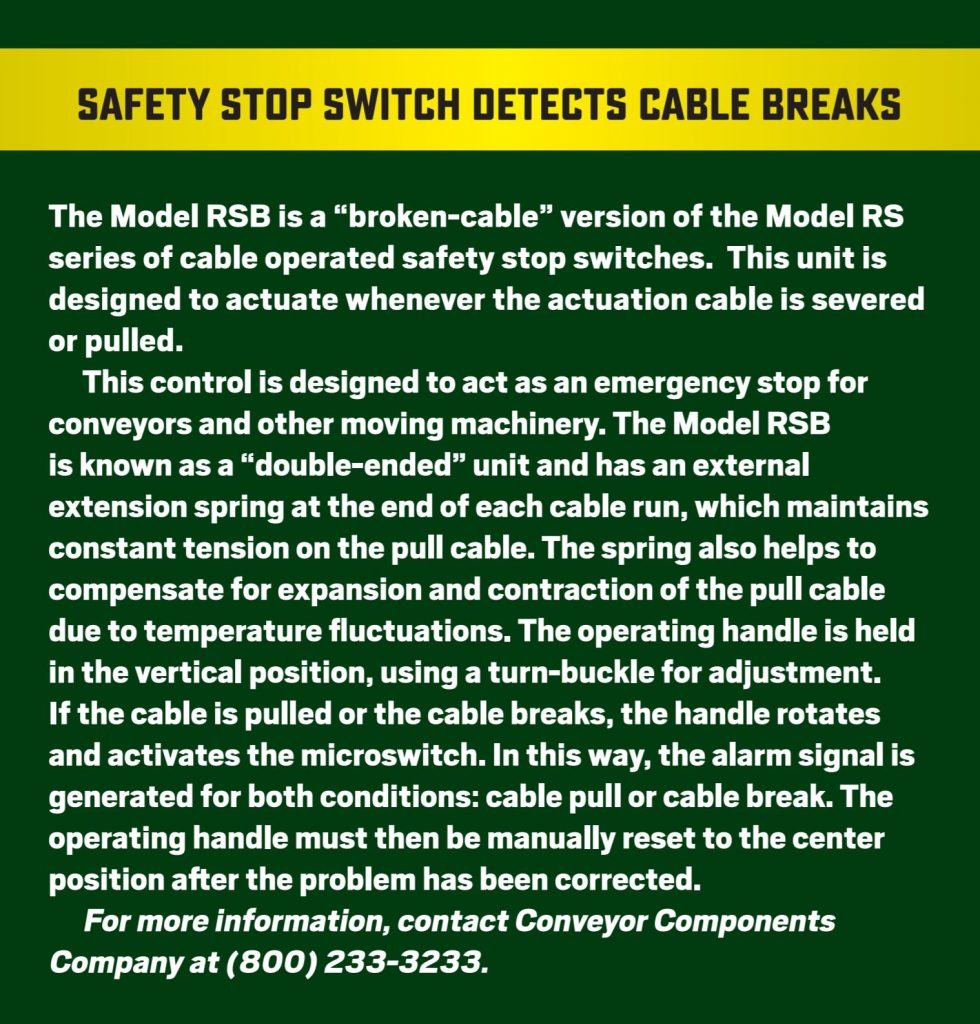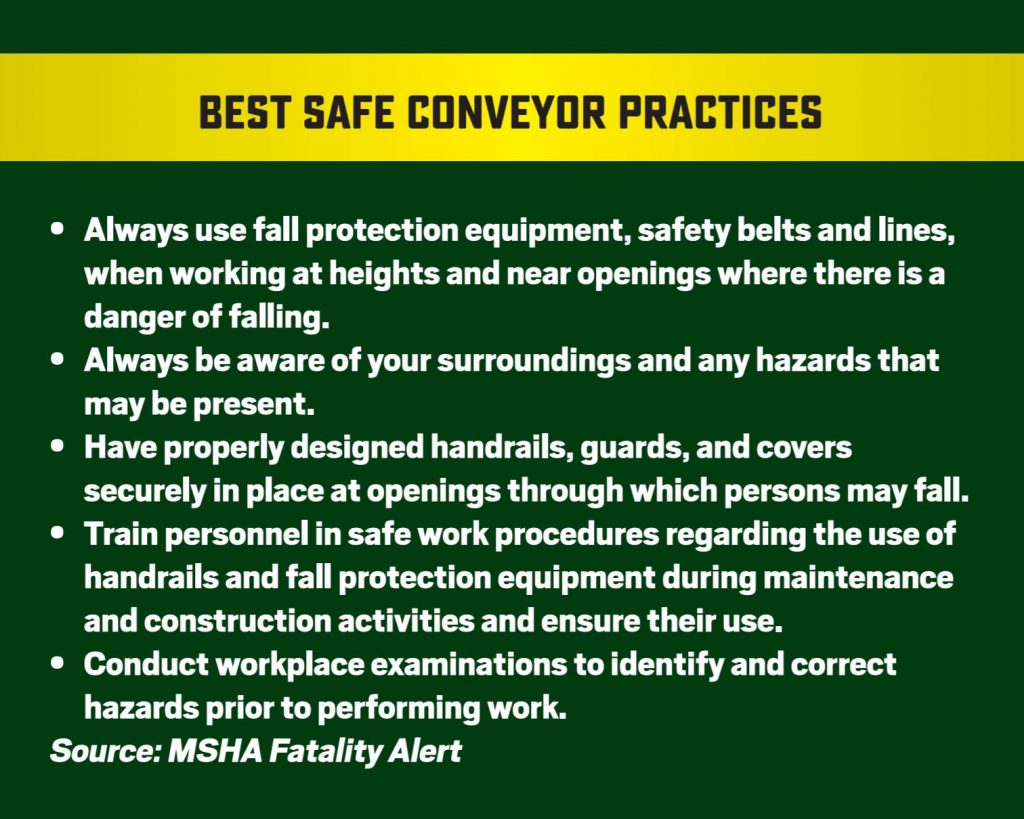Conveyor Safety Best Practices Prevent Accidents
BY AsphaltPro Staff

As long as plants and quarries have conveyors to carry material from point A to point B, workers will be required to maintain conveying equipment. Vigilance and training are only two tools in the arsenal against accidents that occur around conveyors, but owners can improve guarding around maintenance points and can reduce the need for some maintenance tasks, such as cleaning. This sounds like a tall order, but it’s more than worth the effort.
In the first quarter of this year, the U.S. Department of Labor’s Mine Safety & Health Administration (MSHA) issued a fatality alert that a 46-year-old worker with three years of experience was fatally injured when he lost his balance and fell backwards through a narrow gap between two log washers and landed on a cable tray approximately 12 feet below. The victim was changing drive belts on a log washer motor when his wrench slipped off of a bolt he was tightening, causing the loss of balance. (See the sidebar for MSHA’s list of best practices issued following the incident.)
While there are moral and ethical reasons to protect workers around any type of equipment, there are financial reasons to avoid injury for individual companies and the industry overall. During a conveyor safety webinar sponsored by Martin Engineering of Neponset, Illinois, Jerad Heitzler shared some hard truths.
“Whenever we have a conveyor accident, we have the risk of changing regulations for guarding conveyors,” he explained. “We see increased citations. We see increased attention from governing bodies. We see increased documentation. We see upgrades to lockout/tagout enforcement. We see upgrades to training plans. And we see lowered employee retention and morale. When we subject employees to accidents, it’s difficult to attract and keep skilled workers.”
Heitzler shared the story of a worker whose arm was broken in a pinch point while cleaning a conveyor belt. The workers’ peers went to visit the injured employee in the hospital and the scene was like a company meeting but “with an overwhelming feeling of dread.”
Companies combat such horror with a robust safety culture, and with top safety tactics that include a clean work site.
Energy and power are not the same. You want to physically restrain a belt, even if the power has been turned off.
Best Practice Tactics
Heitzler listed four main areas of best practices when working around conveyors, belts, rollers and return conveyors, etc., that we’ll discuss here.
- Proper PPE—While the company is responsible for providing personal protective equipment, each employee is responsible for using it. When working around conveying equipment, employees can’t wear baggy clothing or jewelry. Long hair should be confined.
- Policies, Procedures & Protocol—While the company must have policies in place, it is up to each employee to use procedures correctly. It’s wise to enforce more than lockout/tagout. Heitzler listed: Lock it out; tag it out; use test out procedure; and use block out procedure to eliminate stored energy from tension in the conveyor belt. When you lock out, you eliminate the electricity, but the belt remains a giant rubber band of energy. The block out step eliminates the stored energy from the “stretch” becoming a hazard. By using clamps on the belt and securing it to the structure, you physically restrain it and prevent it from moving. Then you can release the tension when work/repair is complete.
- Training—Take the time to figure out how your employees learn best, and train in that fashion. Heitzel shared that adult learners often need one-on-one, face-to-face conversations to learn new concepts. Only 15 percent of learners will blindly follow a new concept, he explained, so make sure you’re sharing safety messages with facts and data to back up “why” your policies, procedures and protocol are vital.
- Safety Equipment—When training safety concepts, the proper use of safety equipment is vital as well. For example, emergency stop switches can’t be used as the only line of defense at the conveyor belt. The emergency stop switch needs to be tested for slack (you want no more than 12 inches of slack, Heitzel shared) in its cable. The cable de-energizes the conveyor, but the conveyor continues to move until the cable runs out when the switch is tripped. Do your employees understand that hitting the switch doesn’t bring about an immediate stop? When testing the switch, measure, record and report the runout. Inspect the cables and clamps. Inspect the length and location of the stop.
Other safety equipment that can save a life is the guard. The guard around conveyors should have no sharp edges and should have no pinch point at the hinge. You want the guard to be removed only with a tool to access the belt for maintenance. It has to stand out in color from the equipment it’s “guarding” and it must be a proper distance from the hazard, opening or rotating piece of equipment. Heitzel reminded the audience to test the guard with the acronym A.U.T.O. You should not be able to reach: around, under, through or over a guard.

Keep it Clean
Eliminate the hazard by eliminating the need to climb onto equipment for cleaning. Heitzel shared the story of a worker simply sweeping the floor around an elevated conveyor component. The worker slipped and fell 60 feet to his death. Another terrible fact is that workers shoveling fines have had shovels get stuck in pinch points; before anyone could hit a stop switch, the force pulled the workers to a horrible end. Our industry must adhere to dust mitigation rules and regs, so reducing these accidents begins with reducing the need for cleanup. As an industry, we can do a better job of keeping dust from piling up. Heitzel suggested aggregate managers look into the following areas where technologies exist.
- Reduce carryback
- Install proper belt cleaning
- Reduce dust around the belt
- Use skirting, but don’t over-rely on it alone
- Reduce belt sag with proper support
- Maintain wear liners
It’s possible to mechanically control dust to prevent build-up. By limiting dust, we can reduce the opportunities for maintenance and cleaning-related accidents around conveyors.

